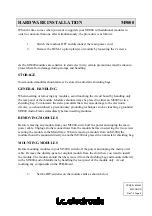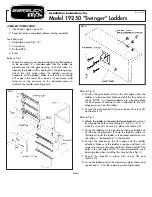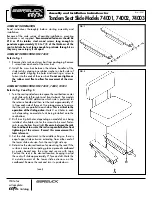
4
SPECIFIC RULES FOR SCAFFOLDING
Safety is a combination of common sense, staying alert and knowing how your item works.
SAVE THESE SAFETY INSTRUCTIONS.
WARNING:
To avoid mistakes and serious injury, read and understand this entire instruction manual.
Learn the tool’s applications, limitations, and possible hazards.
WORK AREA SAFETY
1. Keep your work area clean, uncluttered, and well lit. Cluttered areas invite injuries and accidents. Keep the
ground clear of tripping hazards. Do not work on floor surfaces that are slippery with sawdust or wax.
2. Observe work area conditions. Keep bystanders at a safe distance from the work area. Never allow children or
pets near the tool.
3. To avoid contact and shock hazard, do not use the scaffolding near energized power lines or electrical lines. Do
not contact unprotected, energized electrical power lines or other power sources with the scaffolding or tools. Main-
tain at least 10 feet from electrical lines. Consult the power company to shut off the power or insulate/relocate lines
if a job requires working closer than 10 feet to electrical lines.
4. Only assemble and use the scaffolding on a flat, level surface capable of supporting the tool with its maximum
capacity load. It is easy to lose control if attempting to pull a load on a sloping or uneven surface.
PERSONAL SAFETY
1. Wear ANSI Z87.1-approved impact safety goggles, a hard hat, heavy-duty work gloves and OSHA-specified safe-
ty harness during assembly and use. Wear additional safety gear as required by local, state and federal regulations.
2. Dress for safety. Do not wear loose clothing, neckties, or jewelry (rings, watches, etc.) Always wear non-slip foot-
wear and tie back long hair.
3. Stay alert - watch what you’re doing and use common sense when using the scaffolding. Do not use while you are
tired or under the influence of drugs, alcohol or medication that may affect your ability to properly use the tool. A
moment of inattention while using the scaffold may result in serious personal injury.
SCAFFOLDING USE & CARE
1. Follow all current OSHA (Occupational Safety and Health Administration) guidelines for setup, use and main-
tenance of the scaffolding. Scaffolding safety regulations may change periodically. The operator is responsible for
being familiar with and obeying current OSHA guidelines as well as local, state and federal regulations regarding
the set-up and use of this product.
2. Use the right product for the job. There are certain applications for which this tool was designed. Unauthorized
modification may damage the tool and/or cause personal injuries.
3. Check for damaged or worn out parts before using the scaffolding. Check for alignment of moving parts, jam-
ming, breakage, improper mounting, or any other conditions that may affect the tool’s operation. Any part that is
damaged should be properly repaired or replaced before use. Do not attempt to straighten deformed parts, as this
will weaken their structural integrity. Bent parts should be replaced immediately.
4. Make sure all guards and fasteners are secure after assembly or adjustments. All connections should be tight
before operation.






























